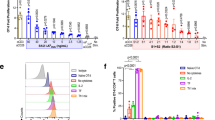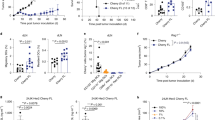Abstract
Human telomerase reverse transcriptase (hTERT) is the catalytic component of a functional telomerase complex, which is important in maintaining cell immortality. In most normal human adult cells, the expression of telomerase is very low and/or transient. In contrast, almost 90% of human tumors express a relatively high level of telomerase implying the possibility of using hTERT as a universal candidate tumor antigen. In this study, we show that human monocyte-derived dendritic cells (DCs) lack telomerase activity. Similar to other normal somatic cells, DCs express the RNA (hTR) component but not the catalytic component, hTERT. We also show that telomerase activity could be reconstituted using either lipid-mediated transfection of the hTERT plasmid DNA or transduction with an E1-, E3-deleted adenoviral vector containing the hTERT gene. However, relative to plasmid transfection, adenoviral gene transfer produced higher levels of hTERT expression. Nine of 10 AdhTERT-transduced DCs were able to generate CTL responses, while only three of nine plasmid-transfected DCs did. CTLs primed against hTERT exhibited killing of telomerase positive but not telomerase negative tumor lines of diverse tissue origins. Antigenic specificity of these T cells to telomerase was further determined by introducing hTERT gene into a telomerase negative cell line, U2OS, by adenoviral transduction. Although some antigenic specificity was directed against adenoviral epitopes, the majority of CTLs were targeted against telomerase-derived antigen(s). Thus, the hTERT gene, particularly as delivered via the recombinant adenovirus, may be useful as vaccine to induce specific T-cell-mediated tumor immunity in cancer patients. In addition, our results suggest that telomerase activity and/or telomerase expression after hTERT gene transfer have a predictive value in the success of hTERT/DC-based cancer vaccination.
This is a preview of subscription content, access via your institution
Access options
Subscribe to this journal
Receive 12 print issues and online access
$259.00 per year
only $21.58 per issue
Buy this article
- Purchase on Springer Link
- Instant access to full article PDF
Prices may be subject to local taxes which are calculated during checkout







Similar content being viewed by others
References
Rosenberg SA . A new era for cancer immunotherapy based on the genes that encode cancer antigens. Immunity. 1999;10:281–287.
Boon TP, van der Bruggen P . Human tumor antigens recognized by T lymphocytes. J Exp Med. 1996;183:725–729.
Rosenberg SA . Cancer vaccines based on the identification of genes encoding cancer regression antigens. Immunol Today. 1997;18:175–182.
Van Pel A, van der Bruggen P, Coulie PG, et al. Genes coding for tumor antigens recognized by cytolytic T lymphocytes. Immunol Rev. 1995;145:229–250.
Blackburn EH . Structure and function of telomeres. Nature. 1991;350:569–573.
Greider CW . Mammalian telomere dynamics: healing, fragmentation shortening and stabilization. Curr Opin Genet Dev. 1994;4:203–211.
Harley CB, Futcher AB, Greider CW . Telomeres shorten during aging of human fibroblasts. Nature. 1990;345:458–460.
Wright WE, Shay JW . The two-stage mechanism controlling cellular senescence and immortalization. Exp Gerontol. 1992;27:383–389.
Hodes RJ . Telomere length, aging, and somatic cell turnover. J Exp Med. 1999;190:153–156.
Weinrich SL, Pruzan R, Ma L, et al. Reconstitution of human telomerase with the template RNA component hTR and catalytic protein subunit hTRT. Nat Genet. 1997;17:498–502.
Bodnar AG, Oullette M, Frolkis M, et al. Extension of life-span by introduction of telomerase into normal human cells. Science. 1998;279:349–352.
Jiang X-R, Jimenez G, Chang E, et al. Telomerase expression in human somatic cells does not induce changes associated with a transformed phenotype. Nat Genet. 1999;21:111–114.
Shay JW, Bacchetti SA . Survey of telomerase activity in human cancer. Eur J Cancer. 1997;33:787–791.
Vonderheide RH, Hahn WC, Schultze JL, Nadler LM . The telomerase catalytic subunit is a widely expressed tumor-associated antigen recognized by cytotoxic T lymphocytes. Immunity. 1999;10:673–679.
Minev BJ, Hipp J, Firat H, et al. Cytotoxic T cell immunity against telomerase reverse transcriptase in humans. Proc Natl Acad Sci USA. 2000;25:4796–4801.
Nair SKA, Heiser A, Boczkowski D, et al. Induction of cytotoxic T cell response and tumor immunity against unrelated tumors using telomerase reverse transcriptase RNA transfected dendritic cells. Nat Med. 2000;6:1011–1017.
Steinman RM . The dendritic cell system and its role in immunogenicity. Annu Rev Immunol. 1991;9:271–296.
Banchereau J, Steinman RM . Dendritic cells and the control of immunity. Nature. 1998;392:245–252.
Hart DNJ . Dendritic cells: unique leukocyte population which controls the primary immune response. Blood. 1997;90:3245–3287.
Ludewig B, Barchiesi F, Pericin M, et al. In vivo antigen loading and activation of dendritic cells via a liposomal peptide vaccine mediates protective antiviral and anti-tumor immunity. Vaccine. 2000;19:23–32.
Bossart P, Wirths S, Stuhler G, et al. Induction of cytotoxic T-lymphocyte responses in vivo after vaccination with peptide-pulsed dendritic cells. Blood. 2000;96:3102–3108.
Hsu FJ, Benike C, Fagnoni F, et al. Vaccination of patients with B-cell lymphoma using autologous antigen-pulsed dendritic cells. Nat Med. 1996;2:52–58.
Nestle FOS, Alijagic S, Gilliet M, et al. Vaccination of melanoma patients with peptide- or tumor lysate-pulsed dendritic cells. Nat Med. 1998;4:328–332.
Thurner B, Haendle I, Roder C, et al. Vaccination with mage-3A1 peptide-pulsed mature, monocyte-derived dendritic cells expands specific cytotoxic T cells and induces regression in some metastases in advanced stage IV melanoma. J Exp Med. 1999;190:1669–1678.
Song W, Kong H-L, Carpenter H, et al. Dendritic cells genetically modified with an adenovirus vector encoding the cDNA for a model antigen induce protective and therapeutic antitumor immunity. J Exp Med. 1997;186:1247–1256.
Dietz AB, Vuk-Pavlovic S . High efficiency adenovirus-mediated gene transfer to human dendritic cells. Blood. 1998;191:392–398.
Wan YP, Emtage P, Zhu Q, et al. Enhanced immune response to the melanoma antigen gp100 using recombinant adenovirus-transduced dendritic cells. Cell Immunol. 1999;198:131–138.
Butterfield LH, Jilani SM, Chakraborty NG, et al. Generation of melanoma-specific cytotoxic T lymphocytes by dendritic cells transduced with a MART-1 adenovirus. J Immunol. 1998;161:5607–5613.
Furumoto KS, Arii S, Yamasaki S, et al. Spleen-derived dendritic cells engineered to enhance interleukin-12 production elicit therapeutic antitumor immune responses. Int J Cancer. 2000;87:665–672.
Boczkowski D, Nair SK, Snyder D, Gilboa E . Dendritic cells pulsed with RNA are potent antigen-presenting cells in vitro and in vivo. J Exp Med. 1996;184:465–472.
Ashley DM, Faiola B, Nair S, et al. Bone marrow-generated dendritic cells pulsed with tumor extracts or tumor RNA induce antitumor immunity against central nervous system tumors. J Exp Med. 1997;186:1177–1182.
Zhang W, He L, Xie Z, et al. Enhanced therapeutic efficacy of tumor RNA-pulsed dendritic cells after genetic modification with lymphotactin. Hum Gene Ther. 1999;10:1151–1161.
Mitchell DA, Nair SK . RNA-transfected dendritic cells in cancer immunotherapy. J Clin Invest. 2000;106:1065–1069.
Koido SM, Kashiwaba M, Chen D, et al. Induction of antitumor immunity by vaccination of dendritic cells transfected with MUC1 RNA. J Immunol. 2000;165:5713–5719.
Philip R, Brunette E, Ashton J, et al. Transgene expression in dendritic cells to induce antigen-specific cytotoxic T cells in healthy donors. Cancer Gene Ther. 1998;5:236–246.
Tuting T, Wilson CC, Martin DM, et al. Autologous human monocyte-derived dendritic cells genetically modified to express melanoma antigens elicit primary cytotoxic T cell response in vitro: enhancement by cotransfection of genes encoding the Th1-biasing cytokines IL-12 and IFN-α. J Immunol. 1998;160:1139–1147.
Manickan E, Kanagat S, Rouse RJD, et al. Enhancement of immune response to naked DNA vaccine by immunization with transfected dendritic cells. J Leukocyte Biol. 1997;61:125–132.
Berlyn KA, Ponniah S, Stass SA, et al. Developing dendritic cells polynucleotide vaccination for prostate cancer immunotherapy. J Biotechnol. 1999;73:155–179.
Kirk CJ, Mule JJ . Gene-modified dendritic cells to use in tumor vaccines. Hum Gene Ther. 2000;11:797–806.
Weber JS, Mule JJ . How much help does a vaccine-induced T-cell response need? J Clin Invest. 2001;107:553–554.
Romani NS, Gruner S, Brang D, et al. Proliferating dendritic cell progenitors in human blood. J Exp Med. 1994;180:83–93.
Kim NW, Fred W . Advances in quantification and characterization of telomerase activity by the telomeric repeat amplification protocol (TRAP). Nucleic Acid Res. 1997;25:2595–2597.
Miyake SM, Makimura M, Kanagae Y, et al. Efficient generation of recombinant adenoviruses using adenovirus DNA-terminal protein complex and a cosmid bearing the full-length virus genome. Proc Natl Acad Sci USA. 1996;93:1320–1324.
Fu S, Diesseroth AB . Use of cosmid adenoviral vector cloning system or the in vitro construction of recombinant adenoviral vectors. Hum Gene Ther. 1997;8:1321–1313.
Rivoltini L, Barracchini KC, Viggiano V, et al. Quantitative correlation between HLA class I allele expression and recognition of melanoma cells by antigen-specific cytotoxic T lymphocytes. Cancer Res. 1995;55:3149–3157.
Tsang KY, Zaremba S, Nieroda CA, et al. Generation of human cytotoxic T cells specific for human carcinoembryonic antigen epitopes from patients immunized with recombinant vaccinia-CEA vaccine. J Natl Cancer Inst. 1995;87:982–990.
Chiu CP, Dragowska W, Kim NW, et al. Differential expression of telomerase activity in hematopoietic progenitors from adult human bone marrow. Stem Cells. 1996;14:239–248.
Bodnar AG, Kim NW, Effros RB, Chiu CP . Mechanism of telomerase induction during T cell activation. Exp Cell Res. 1996;228:58–64.
Harle-Bachor C, Boukamp P . Telomerase activity in the regenerative basal layer of the epidermis in human skin and in immortal and carcinoma-derived skin keratinocytes. Proc Natl Acad Sci USA. 1996;93:6476–6481.
Bachor C, Bachor OA, Boukamp P . Telomerase is active in normal gastrointestinal mucosa and not up-regulated in precancerous lesions. J Cancer Res Clin Oncol. 1999;125:453–460.
Wright WE, Piatyszek MA, Rainey WE, Byrd W, Shay JW . Telomerase activity in human germline and embryonic tissues and cells. Dev Genet. 1996;18:173–179.
Horikawa IP, Cable L, Afshari C, Barrett JC . Cloning and characterization of the promoter region of human telomerase reverse transcriptase gene. Cancer Res. 1999;59:826–830.
Takakura M, Kyo S, Kanaya T, et al. Cloning of human telomerase catalytic subunit (hTERT) gene promoter and identification of proximal core promoter sequences essential for transcriptional activation in immortalized and cancer cells. Cancer Res. 999;59:551–557.
Cong YS, Wen J, Bacchetti S . The human telomerase catalytic subunit hTERT: organization of the gene and characterization of the promoter. Hum Mol Genet. 1999;8:137–142.
Majumdar AS, Hughes DE, Lichsteiner SP, et al. The telomerase reverse transcriptase promoter drives efficacious tumor suicide gene therapy while preventing hepatotoxicity encountered with constitutive promoters. Gene Ther. 2001;8:568–578.
Acknowledgements
We thank Lisa Cardoza for constructing the AdhTERT virus used in this study and Brian Murphy and Sharon Wang for providing excellent technical assistance. We also thank Drs Cal Harley and Iris Ferber for the critical reading of the manuscript.
Author information
Authors and Affiliations
Corresponding author
Rights and permissions
About this article
Cite this article
Frolkis, M., Fischer, M., Wang, Z. et al. Dendritic cells reconstituted with human telomerase gene induce potent cytotoxic T-cell response against different types of tumors. Cancer Gene Ther 10, 239–249 (2003). https://doi.org/10.1038/sj.cgt.7700563
Received:
Published:
Issue Date:
DOI: https://doi.org/10.1038/sj.cgt.7700563
Keywords
This article is cited by
-
A second chance for telomerase reverse transcriptase in anticancer immunotherapy
Nature Reviews Clinical Oncology (2017)
-
Transgene expression of α tumor necrosis factor with mutations D142N and A144R under control of human telomerase reverse transcriptase promoter eradicates well-established tumors and induces long-term antitumor immunity
Cancer Gene Therapy (2009)
-
A simplified system for generating oncolytic adenovirus vector carrying one or two transgenes
Cancer Gene Therapy (2008)
-
Recent developments in the use of adenoviruses and immunotoxins in cancer gene therapy
Cancer Gene Therapy (2007)
-
HER-2/neu-gene engineered dendritic cell vaccine stimulates stronger HER-2/neu-specific immune responses compared to DNA vaccination
Gene Therapy (2006)



